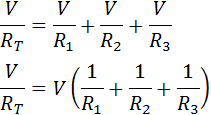Resistors in Parallel
Parallel Combination Of Resistors
R1, R2, and R3 are three resistors connected across voltage source V. I1, I2 and I3 are three current following in R1, R2, and R3 respectively. It is the total current of the supply source, as shown in Figure.
From this figure, we understand that
IT = I1 + I2 + I3
We know that
V=IR---> (1)
I = V/R--> (2)
Put eq (2) in eq (1) we get

By dividing Both Sides by V we get

In General

Where n = 1,2,3,4,..........
RESISTORS IN PARALLEL CHARACTERISTICS
There are the same voltages across each resistor in parallel ckt.
VT = V1 = V2 = V3
- In each resistor the flow of current depends on the value of the resistor is so small amount of current in that resistor as compared to that resistor whose value is less.
The total current is equal to the sum of that current which flows in each resistor.
IT= I1 + I2 + I3

The total ckt resistance is equal to the sum of the conductance of ckt. OR The total ckt resistance is equal to the sum of the reciprocal of the ckt.

OR
GT=G1+G2+G3
- If we increase the resistor in that ckt the total resistance will decrease
- As there are different paths for the current if the fault occurs in a resistor, the operation of the other resistor continues.
- In that ckt, the amount of the total resistance is also less than the amount of the small resistor of the ckt.
- The path of the current flow is equal to the parallel path of the ckt.
- The total power and energies are equal to the sum of each path.
- These ckt are used commonly.
Category
